For August, I decided that my efforts needed to be directed towards a few new areas that would be challenging for me. I wanted to get more terrain for my games, specifically some that would be useful in making my Combat Patrol™ games more visually appealing to the players. I also wanted to try to use some new techniques and incorporate new materials into my hobby kit bag.
This would involve working on things and using multiple materials with which I am less than fully experienced. My goal was to stretch my horizons as it were, and this goal also dovetailed nicely with the monthly painting challenge run by our Australian friend Azazel. The theme for August was “Technical August”, which was a wide-open challenge to try or improve upon techniques that we had little to no experience in doing previously. With that said, I decided that assembling, building, and painting some Armorcast terrain would be a good way to do that. Mainly my goal was to focus on using the five 4-pigment bottle sets of Vallejo Pigments that I have not really used (Dust & Dirt, Mud & Sand, Rust & Corrosion, Soot & Ashes, and Stone & Cement). I did use the Soot & Ashes set on some cheap 3D printed buildings, but otherwise not much.
I acquired three types of Armorcast resin terrain (all suitable for 28mm scale) for the August challenge – craters, ruined buildings, and sci-fi ruined walls:
- 1 ACCR001 3-crater set (includes 3 differently-sized impact craters – 6″, 4″, and 3″ – and the set is the subject of this post)
- 5 ruined building corners (subjects of a future post)
- 6 sci-fi walls (subjects of a future post)
- 1 ACW007 High Tech Walls 2 (each set includes 2 walls)
- 2 High Tech Walls 1 (each set includes 2 walls)
As for my technical goals, my list of “challenge” skills, materials, and techniques include:
- Assembling, building, and basing terrain
- Use of materials to create weathering and rusting effects, to include:
- Vallejo Pigments, to include application and fixing (covered in this blog post)
- Vallejo Mecha Color weathering products
- Weathering and rusting/oxidizing effect products, to incude:
- Citadel Technical paints:
- Typhus Corrosion
- Ryza Rust
- Nihilakh Oxide
- Vallejo and Vallejo Mecha Color rusting and weathering products
- Vallejo Pigments (various)
- Vallejo Game Air rusts (71.069 and 71.080)
- Vallejo Mecha Color Weathering products
- Oil Stains (gloss)
- Rust Wash
- Rust Texture (Matt)
- Citadel Technical paints:
- Create a new storage system for my terrain pieces
The ones above in bold font are ones I worked on for the 3-crater project. Others will be used for the remaining projects, even if that lasts into September (which is likely).
I had previously worked on some Armorcast sci-fi pieces and grenade blasts. I like their products, but wanted to get better at getting them on the tabletop.
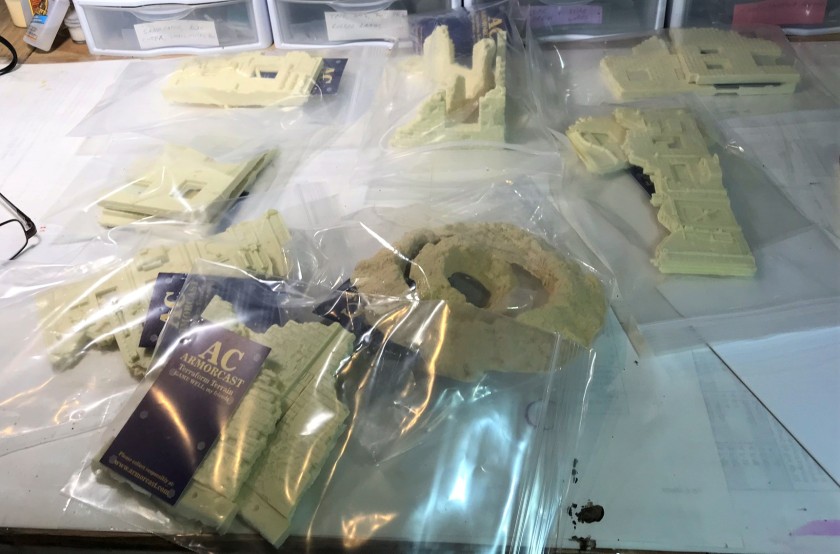
I got good advice from Armorcast (Gin Fritter) and Buck Surdu about preparing the resin for painting. I ended up using a few Exacto knives to remove flash, and then used Scotch-Brite pads to lightly (imperceptibly in fact) give the pieces a rubdown to achieve a “bite” for airbrush priming. Additionally, I used a 180 grit sandpaper sheet to scuff up the craters’ bottoms so that they would glue better to their planned bases. I then washed the pieces thoroughly with dish washing soap in the sink and let them dry.
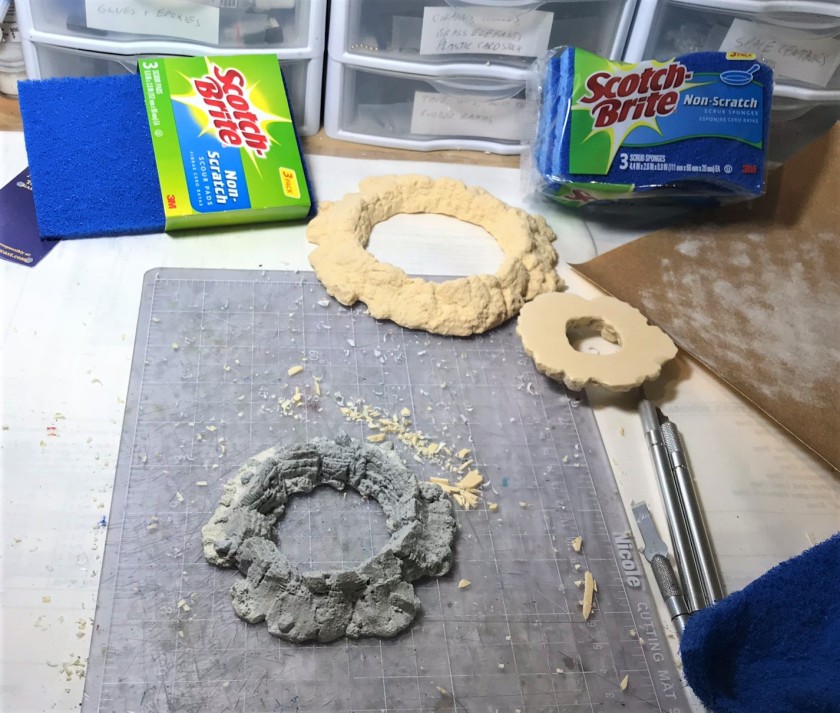
For basing, I chose to incorporate a few different materials. First, I cut irregular shapes from Evergreen Scale Models #9020 polystyrene sheets – which is quite thin (.020″/0.5 mm). I mounted the crater pieces to the cut shapes with Gorilla Glue. Then, I also used a number of differently sized thin steel bases from Wargames Accessories to mount under the shapes for both strength and to be able to later store and transport securely in magnetically lined storage boxes (which is another project in and of itself that I have planned). Here, I also used Gorilla Glue.

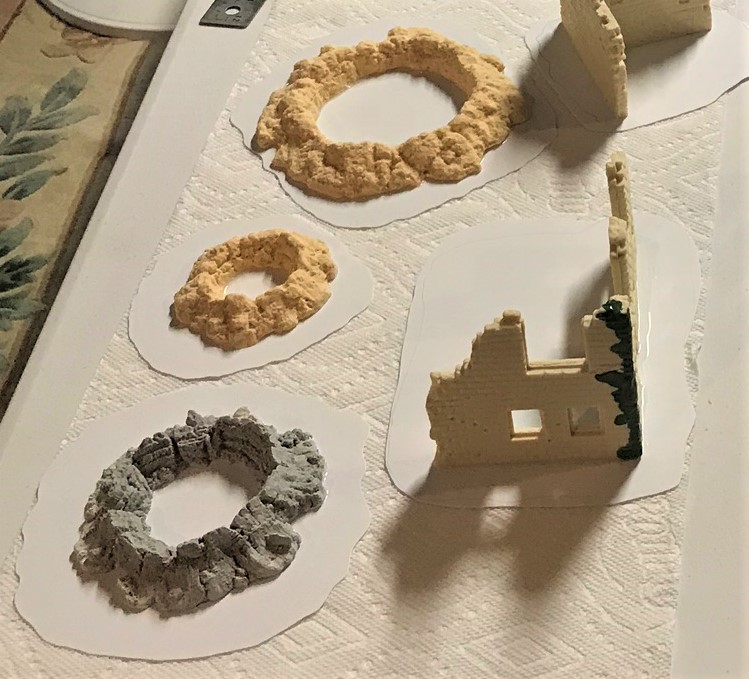
From my minimal experience with using pigments, I knew they had the potential for a huge mess. I learned that using a cafeteria-type tray would make using them easier. I hit my local Salvation Army and found four trays for this use. Interestingly, three of them were from a former Digital (DEC) facility (there were a lot of them in Massachusetts before Compaq and later Hewlett Packard consumed them in 1998). I removed what appeared to be ancient chili from them, and put them into use. I also got a small palette from Michael’s craft store to use just for pigments. I put that palette into a deep plastic Rubbermaid salad container, and I thereby effectively limited the migration of pigments from my work space. You definitely do not want to have a fan or strong air circulation going while using pigments!

I then used PVA glue (good old Elmer’s) to affix some play sand and some Woodland Scenics stones to the bases, and let them harden.

Next, in order that I could handle and work with the craters, I affixed their bases with poster tack to upside-down plastic plates before priming. I marked each plate with a brown ink line for reference, and proceeded to airbrush prime the set with Vallejo “Surface Primer – Gray”.

I then worked on the three craters sequentially, going from smallest to largest. For the smallest one, I dry brushed with multiple shades of brown (there is a list of materials that I used at the end of this blog). I was not sure that I needed to or if the pigments would be enough. Primarily, I used the four pigments from the Vallejo “Mud and Sand” set (“Light Yellow Ochre”, “Natural Umber”, “Light Sienna”, and “Light Slate Grey”) plus the Vallejo “Faded Olive Green”. I looked at the Vallejo YouTube video on pigments, and used some of the different techniques to apply and fix the pigments.
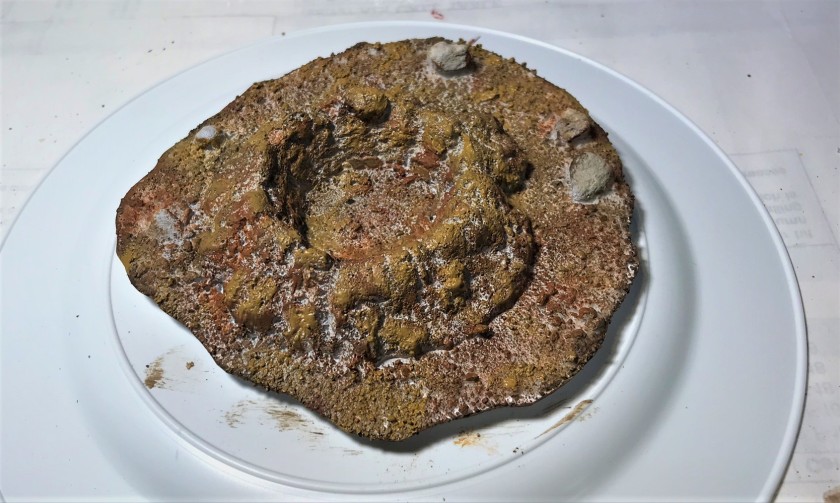

After this, I moved on to the next larger crater, and also dry brushed it and used the same method of fixing the pigments. One downside that I discovered was that the airbrush thinner tended to dissolve the PVA holding the rocks in place (but not the sand). I replaced the displaced rocks on the bases after the airbrush thinner dried.

Lastly, I worked on the largest crater. Here, I passed on doing any dry brushing. For this one, I employed Vallejo “Pigment Binder” instead of the airbrush thinner to fix the pigments – and to prevent the dissolving issue under the added rocks. I also needed to use Secret Weapons Washes “Sewer Water” to give better shading. While the pigment binder worked, it did lead to a thicker application of pigment as you see below. I thought it blended too much – and I believe that one should use that product selectively. I subsequently added more pigments to make the crater less of a solid olive green, fixing them with airbrush thinner. It worked.

Lastly, I decided to airbrush varnish the craters. Did I need to? I wanted to protect the paint work, so I did. I do think I needed to thin the varnish more, as I had some crazing to deal with, something I had not seen previously with its use on miniatures. To help with color variety, I applied Citadel “Agrax Earthshade” and “Athonian Camoshade” washes, mixed with a little varnish and applied with a brush to the affected areas. I then applied Army Painter “Wasteland Tufts” and some 12 mm grasses from Shadow’s Edge Miniatures.
As an aside – I can say without a doubt that the Shadow’s Edge Miniatures products are far superior to Army Painter’s – they need no additional gluing, and they are visually stunning. I plan on using their products, especially the flowers, on future unit bases to help with tabletop differentiation.


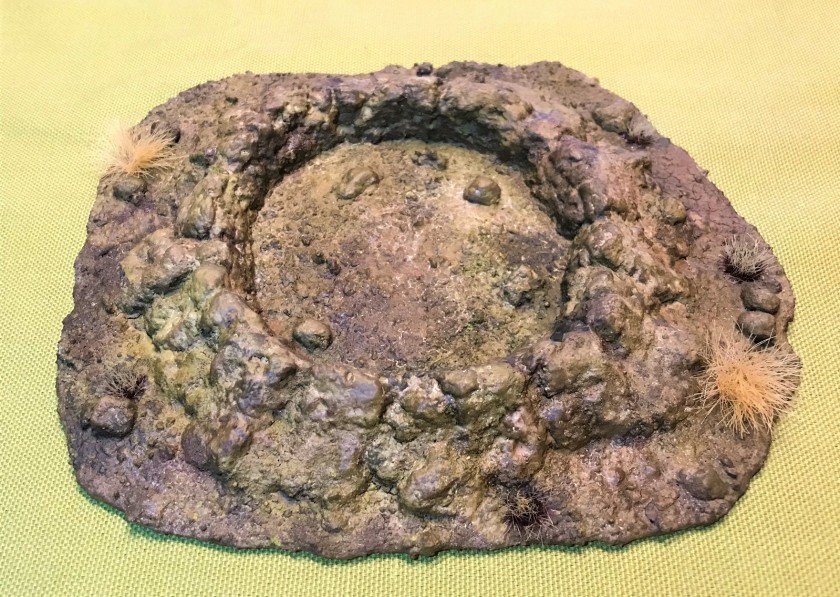
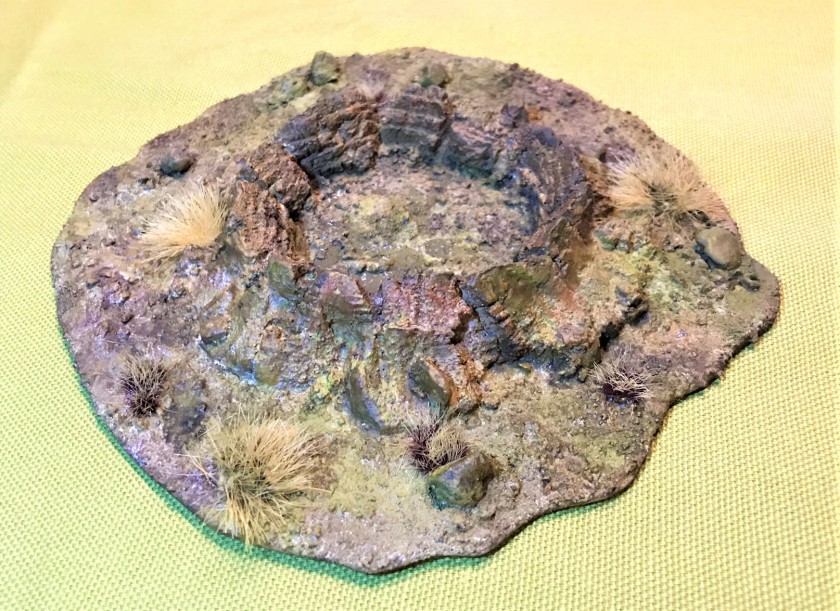
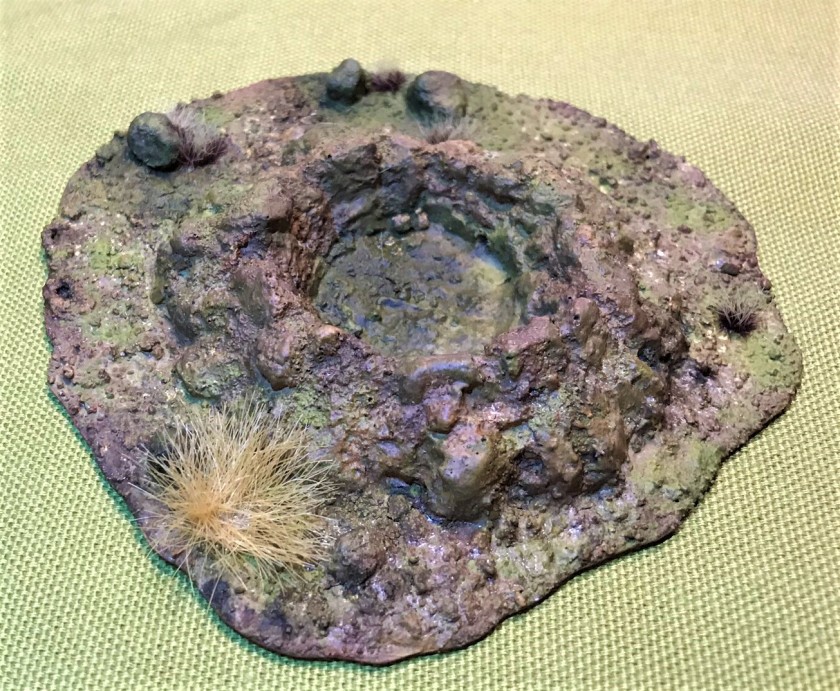
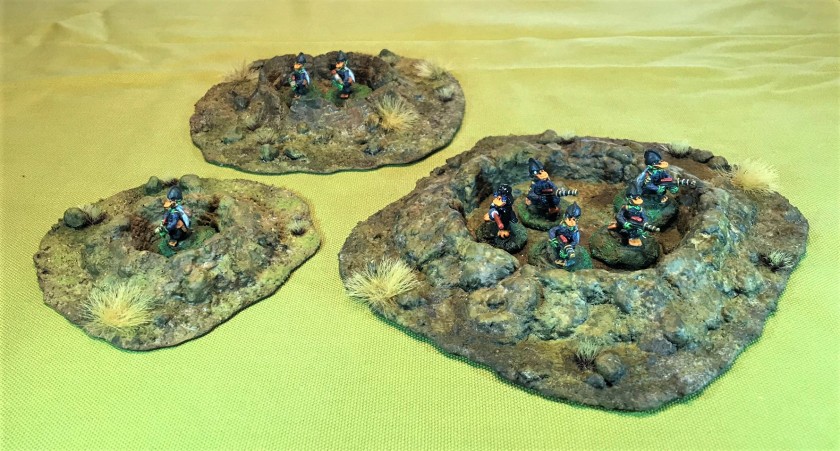
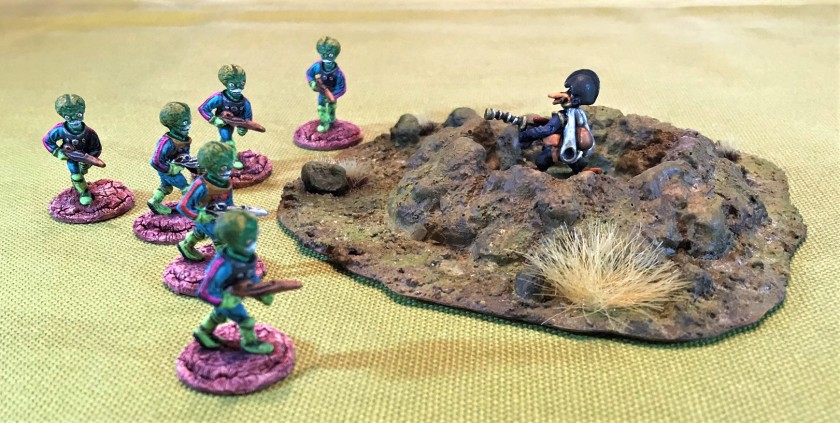

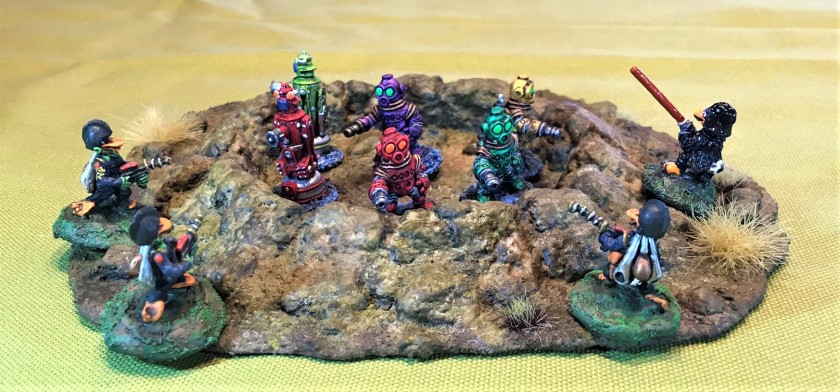
My lessons and thoughts from the project:
- The cleaning and scrubbing of the resin helped with the priming. The Scotch-Brite pads work well for this use.
- For terrain pieces that will be totally covered in pigments, dry brushing with paint is not needed. When I get to doing vehicles, such as tanks, it will be interesting to see how that works.
- Fixing pigments with airbrush thinner is easier than with pigment binder. However, add any additional large features, such as extra rocks later, or use pigment binder on the rocks.
- Having trays and palette wells (such as the one I put my palette in) while working with pigments cuts down on the mess considerably. Be ready to use multiple brushes, both wet and dry. The mess vacuumed up or washed off easily from my palettes and trays.
- Always ensure your pigment bottles are shut tight. I see how they could spill over easily (and I was lucky enough not to have this problem).
- PVA glue and play sand are an inexpensive winner.
- The combination of thin steel and thin polystyrene yields a model base with little to any “rise” from the tabletop at its edge, and is strong.
- Thin your varnish to prevent the crazing! (Speaking with Buck today, he uses varnish to fix his pigments, so that needs to be considered). I also want to see how well airbrushing the thinner fixes pigments in future projects, like my ruined buildings.
- Washes help in the end for touch ups.
- Shadow’s Edge Miniatures tufts are fantastic – need no extra glue and dry clearly.
Now the three craters are now ready to join my other terrain. Hopefully I can get more done this month.
Thanks for reading and if you have feedback, especially on my results or suggestions from your experiences, please, share them in the comments section. I do so much appreciate them!
PAINTS, PIGMENTS, INKS, GLUES, GLAZES, WASHES, AND FLOCKING USED:
- Vallejo “Surface Primer – Gray”
- Generic play sand
- Elmer’s “Glue-All”
- SceneARama “Rocks”
- Evergreen Scale Models #9020 0.5 mm plain polystyrene sheets
- Gorilla Glue
- Wargames Accessories steel bases (various)
- Americana “Raw Umber”
- Citadel “XV-88”
- American “Burnt Sienna”
- Citadel “Skrag Brown”
- Citadel “Balor Brown”
- Vallejo “Natural Umber” (pigment)
- Vallejo “Light Yellow Ochre” (pigment)
- Vallejo “Light Slate Grey” (pigment)
- Vallejo “Light Sienna” (pigment)
- Vallejo “Faded Olive Green” (pigment)
- Vallejo “Airbrush Thinner”
- Vallejo “Pigment Binder”
- Vallejo “Airbrush Flow Improver”
- Secret Weapons Washes “Sewer Water” (wash/shade)
- Citadel “Agrax Earthshade”
- Citadel “Athonian Camoshade”
- Testors “Universal Acrylic Thinner”
- Vallejo Mecha Varnish “Matt Varnish”
- Army Painter “Wasteland Tufts”
- Shadow’s Edge Miniatures “12 mm tufts”
Thanks again – I hope this helps you or please feel free to add your own suggestions in the comments section. After all, I am no expert in these – and I am just sharing my lessons learned – and I KNOW there are many other ways to accomplish what I did (I just don’t know them all!!).


Very nice results mate, and thanks for sharing your insights!
LikeLiked by 2 people
Appreciate that Alex!
LikeLiked by 1 person
These look great mate and I enjoyed the read/tutorial. What is the capillary action technique? I’ve never bought anything from armocast but this post of yours has me thinking hehe.
LikeLiked by 1 person
Thanks IRO. The capillary technique is taking a clean brush, dipping it into the airbrush thinner, and letting a drop touch the pigment. The thinner then spreads across the dry pigments by capillary action. You then go across the model until there are no more dry spots.
As for Armorcast check out their website, there’s a lot of stuff that is right up your creative alley!
LikeLiked by 1 person
Ahh I see, that’s cool
LikeLiked by 1 person
Love it Mark, very informative post. And your miniatures makes me think about my Mutant 1984 project lying dormant at the moment!
LikeLiked by 1 person
Glad you found it useful One. My miniature niche is to fine miniatures that are cool, usually OOP, and put together units of stuff most folks never see. Check out some of my older posts to see what I mean. Mutant 1984 sounds cool!
LikeLike
Excellent work, Mark. They look really good!
LikeLiked by 1 person
Thanks again for your advice and counsel oh great one!
LikeLike
They look great Mark! Fixing the craters to the plastic sheet bases lets you get a lot more room to add grass tufts etc. to really give them presence! On a balance, do you think you’re happier with the finish you get going down the pigment route? I must admit, I like how they’ve all turned out!
LikeLiked by 2 people
Much appreciated JNV! I do like the finish on these versus paint as they are terrain pieces and the blending works. I’ve got some buildings and walls to try some pigments in combination with painting and weathering/rust. My goal is to have another tool in my hobby armamentarium! Have you had a different experience in your projects?
LikeLiked by 1 person
I think if you’re happy with a new method that works, that makes it worthwhile, particularly since the results are so good. I’m trying to get a balance between washes and drybrushing mainly, along with different base materials, so not pushing back any boundaries. My aim is to try and speed up painting without dropping standards too much – I’ve got way too much painting to do!
LikeLiked by 1 person
Yeah, I’m in agreement. When I get to doing tanks, I’m hoping I can effectively use the pigments. I also got this book, which gave me some ideas. Not planning on using the same paints, but I found it thought provoking. He also has some nice stuff on YouTube
https://www.migjimenez.com/en/books/315-painting-wargame-tanks.html
LikeLiked by 1 person
Interesting stuff Mark, I’ve never tried pigments, I’ve always just painted my scenery in the usual manner (I’m terribly conservative you know), I really should try pushing the boundaries a bit, especially after seeing the great results you have achieved. I might have gone in with a final light dry-brush with a much lighter colour say coffee, just add some highlights around the edges of the craters, but they look amazing.
Cheers Roger.
LikeLiked by 1 person
Thanks Roger and I agree with your assessment. The photos don’t really show it but I used more of the “Light Sienna” pigment at the end but at that point I wanted to fix everything and move on. Going back to paint at that point would have worked, A dry brush application is a great suggestion (I’m assuming you meant maybe coffee with cream?). In any case, really appreciate the kind words and the suggestion, very helpful! Best, Mark
LikeLike
Ha ha, yes sorry Mark I did mean a pale coffee (it’s the name of a paint colour I use a lot.
Cheers Roger.
LikeLiked by 1 person
I guess I read your mind Roger (I’m a tea drinker anyways😄)!
LikeLike
Great post- tons of useful info there and the craters have turned out lovely too.
Cheers,
Pete.
LikeLiked by 1 person
Thanks Pete. As a former Combat Engineer officer, I always want those following after me to know where the mines are – so hopefully that is the case here!
LikeLiked by 1 person
Looks great, Mark. The basing and powders really worked out well – they look like real, aged battlefield craters! If I can make a suggestion for the overall tabletop – there are some really great looking neoprene mats out there now that these craters and your other terrain would look amazing on!
LikeLiked by 1 person
Funny you should say that because neoprene battle mats are definitely on my wish list. I’m just not sure which ones to get (they would need to be 6’ x 4’), and they are indeed expensive. So, I want to get the right ones, preferably with travel bags. I also want them generic enough for multiple scenarios and use of my terrain. For the games I run, I figure I need a Mars landscape, a Western European/green fields landscape, and a dark apocalyptic landscape. Most of what I’ve seen has been around $75 US each. Definitely been checking some out, but I’ve not been able to pull the trigger yet. I’m open to suggestions!
LikeLiked by 1 person
These guys have mats that would fit your needs.
https://www.gamemat.eu/our-products/battle-mats/6-x4-g-mats/us/
I’ve got several of them myself and they’re pretty good. You do need to buy the bags separately from them though for a couple of bucks each.
LikeLiked by 1 person
Thanks Azazel. I remember the days when we used a couple OD (olive drab) US Army wool blankets. I got three tarps (which is what you see here) and a black car headliner. I’m going to do some serious looking and order from somebody soon. Much appreciate the link!
LikeLiked by 1 person
FYI Azazel, I ordered a couple from them (the Wasteland and the Highland Battle 6’ x 4’) so appreciate all the links from you and others. The travel bags are listed as being part of the purchase so looking forward to their arrival from Prague!
LikeLiked by 1 person
I bought a couple of Deep Cut Studios mats from Wayland Games in the UK and they’re very nice. They originate from either Latvia or Lithuania, can’t remember which, and I got a Badlands one for WW1, a sea mat for naval games and a beach mat for amphibious landings. They come in vinyl, synthetic cloth or mouse mat material, in increasing prices – I went for the cloth ones and used a cool iron to remove the creases (my wife didn’t know I could iron)!
LikeLiked by 2 people
Thanks I see that they are customizable too. Definitely going for neoprene. Any feedback on those?
LikeLiked by 2 people
No probs, Mark. I’ve also purchased mats from Urbanmatz. Here’s some of my reviews (never got around to doing them all) – maybe when I get some time off work I’ll do some more of them…
https://azazelx.com/2017/04/03/review-urbanmatz-6×4-badlands-game-mat/
https://azazelx.com/2017/06/14/review-urbanmatz-6×4-dirty-roads-game-mat/
https://azazelx.com/2017/02/11/review-urbanmatz-6×4-snow-territory-game-mat/
https://azazelx.com/2017/01/23/reviews-fantasy-flight-games-x-wing-3×3-starfield-mat-urbanmatz-6×3-space-themed-game-mat/
LikeLiked by 2 people
Thanks I do need to get some, with my new terrain it will work well! Clearly you have done your homework and I appreciate your sharing!
LikeLiked by 1 person
Wow Mark, those are some nice looking craters! Great job on pushing yourself to try out pigments. That’s one on my list, but probably not for awhile now. The serving trays are ingenious, and wish I had thought of that. Would probably help a lot when I’m doing some green stuff or scraping work. Congrats on Tech’ing it out through August! 🙂
LikeLiked by 1 person
Thanks Faust! Pigments have impressed me for sure.
LikeLiked by 1 person
Mark, the craters look really great, I really like you trying all of the techniques you tried. I have made some of my own craters using foam board, rocks, sand and latex caulk. Based on what I saw you did with pre-made craters I’m sure you could make your own craters, dug in markers and trench works that would look exceptional. Congratulations and keep up the experimentation.
Scott
Ps love the Ducks
LikeLiked by 1 person
Thanks Scott! I only wish I was a faster painter/modeler! And glad you like the Star Ducks!
LikeLike
Don’t seem to have the option to reply to your question on mats above, so have just jumped in here, so hope this makes sense! I’ve got synthetic cloth mats and am happy with using and storing them. My mate has a PVC mat for starship combat and that seems OK (although I do prefer cloth). I haven’t seen the mousemat-material-backed mats though so not sure how well they store or how easy it might be to get creases out. And of course you have Cigar Box mats in the US, who I think print on a fleece material (never seen their mats unfortunately).
Thanks for the link to the Painting Wargames Tanks book – that’s now on my wish list!
LikeLiked by 1 person
That book is awesome. Also appreciate the gaming mat feedback, looks like I will go with neoprene, just with which one….
LikeLike
Sorry for the late reply mate ,been a bit slack what with trying to get work up to date and painting stuff for my next dio before going to the UK for the big holiday in a coupla weeks ! .Great job mate so realistic you certainly put a lot of effort into your painting .
LikeLiked by 1 person
No worries I’m trying to catch up too!
LikeLiked by 1 person
And I appreciate the kind words!
LikeLiked by 1 person
Great post and tutorial Mark and they look great too!
LikeLiked by 1 person
Thanks TIM! Your dioramas helped inspire me, on this crater project and a couple of others in the works as well. Hope your holiday (we call it vacation!) was nice.
LikeLiked by 1 person
I’m flattered Mark, thank you. As for the vacation it was great, just a shame to come home to so much work!
LikeLiked by 1 person
Very nice and realistic looking results on those craters. They have an aged battlefield look to them, like no mans land that has been fought over for decades. Regarding battle mats, I have three from UrbanMatz myself I am happy with (mouse mat material). One of them being the Badlands mat that Azazel has reviewed above. I think that could go well with these craters too. The others I have are Asphalt for my sci-fi and Cobblestone for Frostgrave/Mordheim.
LikeLiked by 1 person
Thanks Subedai! I did order a couple from gamemat.eu them (the Wasteland and the Highland Battle 6’ x 4’). Feels like I bought a golf club cost-wise, but I am looking forward to seeing them soon from Prague!
LikeLiked by 1 person
Those look really incredible. It’s amazing seeing things like this come together. The Natural Umber (I think that was what it was called but I’m commenting on my phone so can’t check) really started tying it together and then bam – like magic – everything else fell into line. Awesome job Mark!
LikeLiked by 1 person
You are very kind to say that Luke, thank you! I’d like to say it all fell into line easily, but there was a learning curve. I actually had to go buy more Natural Umber today!
LikeLike